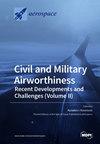利用遗传算法和 IGP 参数化优化机翼升力系数:第 1 卷
IF 2.2
3区 工程技术
Q2 ENGINEERING, AEROSPACE
引用次数: 0
摘要
本研究的目的是开发一种遗传算法,利用 IGP 参数化提高无人机(UAV)机翼上使用的三种翼面的升力系数(CL)。通过开发使用 IGP 参数化的遗传算法,对三个基准翼面的几何形状进行了修改,并在 MATLAB 环境中使用 XFOIL 进行了气动分析。随后,使用商用计算流体动力学(CFD)代码为每个基准翼面和优化翼面制作了一个数值模型,以分析升力系数的行为。Eppler 68、MH 70 和 Wortmann FX 60-126 机翼的平均升力系数在攻角 0 至 10 范围内分别增加了 17.243%、14.967% 和 10.708%。此外,在 XFOIL 和 CFD 的升力系数计算中获得了平均 5.027% 的不确定性。这证明了 IGP 方法和遗传算法在机翼参数化和优化方面的实用性。此外,还可根据任务情况为特定无人机量身定制机翼。本研究的第二卷将包括来自风洞的实验数据。本文章由计算机程序翻译,如有差异,请以英文原文为准。
Airfoil Lift Coefficient Optimization Using Genetic Algorithm and IGP Parameterization: Volume 1
The objective of this study is to develop a genetic algorithm that uses the IGP parameterization to increase the lift coefficient (CL) of three airfoils to be used on wings of unmanned aerial vehicles (UAVs). The geometry of three baseline airfoils was modified by developing a genetic algorithm that operates with the IGP parameterization and performs the aerodynamic analysis using XFOIL in the MATLAB environment. Subsequently, a numerical model was made for each baseline and optimized airfoil using a commercial computational fluid dynamics (CFD) code to analyze the behavior of the lift coefficient. An increase in the average CL was obtained for the Eppler 68, MH 70, and Wortmann FX 60-126 airfoils for angles of attack ranging from 0 to 10, obtaining increments of 17.243%, 14.967%, and 10.708%, respectively. Additionally, an average 5.027% uncertainty was obtained in lift coefficient calculations between XFOIL and CFD. The utility of the IGP method and genetic algorithms for parameterizing and optimizing airfoils was demonstrated. In addition, airfoils could be tailored for a specific UAV depending on the mission profile. Volume 2 of this study will include experimental data from wind tunnel.
求助全文
通过发布文献求助,成功后即可免费获取论文全文。
去求助
来源期刊

Aerospace
ENGINEERING, AEROSPACE-
CiteScore
3.40
自引率
23.10%
发文量
661
审稿时长
6 weeks
期刊介绍:
Aerospace is a multidisciplinary science inviting submissions on, but not limited to, the following subject areas: aerodynamics computational fluid dynamics fluid-structure interaction flight mechanics plasmas research instrumentation test facilities environment material science structural analysis thermophysics and heat transfer thermal-structure interaction aeroacoustics optics electromagnetism and radar propulsion power generation and conversion fuels and propellants combustion multidisciplinary design optimization software engineering data analysis signal and image processing artificial intelligence aerospace vehicles'' operation, control and maintenance risk and reliability human factors human-automation interaction airline operations and management air traffic management airport design meteorology space exploration multi-physics interaction.
 求助内容:
求助内容: 应助结果提醒方式:
应助结果提醒方式:


